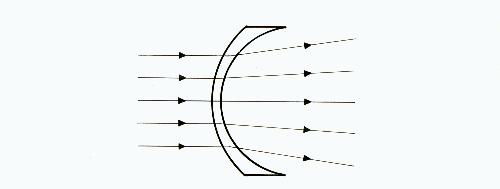
Fig. 1

Fig. 2
Chapter 3
WHY THE USUAL TREATMENT FOR MYOPIA IS HARMFUL
Assume that a child has just begun to become nearsighted. This means that the ciliary muscle spasm, which has been useful in reducing the infantile farsightedness to zero, is now threatening to cause the eye to continue to elongate and become permanently myopic. The most natural way to relax the spasm, return the vision to normal, and prevent overelongation is to have the child give up all close work and take up activities which only require distance vision. This prescription, since it would mean not going to school and not learning to read, is clearly impractical in our modern society. Other methods must be found that will "fool" the eyes so that the close work can be done with the eyes focused for distance. These methods will be described in a later chapter. What we will deal with now is the usual treatment for myopia, why it is disastrously wrong, and why it does so much damage to the vision. Understanding this problem will require that you learn something about the technical details of lenses.
Minus lenses. Myopic people require concave or minus lenses to give them clear distance vision. Figures 1 and 2 show two forms of minus lenses. Note that both lenses are thinnest in the center and thickest at the outside or periphery.

Fig. 1

Fig. 2
Figure 1 shows the shape of the lenses usually used for eyeglasses or contact lenses; figure 2 is a simplified version, which we will use for the diagrams that follow. A minus lens causes rays to diverge as figures 1 and 2 indicate.

Fig. 3
Figure 3 shows a myopic eye in which the amount of myopia is exaggerated for the purpose of illustration.
Because of the ciliary spasm, the lens cannot relax sufficiently to enable the parallel rays from a distant object to come to a focus on the retina. The object appears blurred. The child is taken to the doctor and fitted with a pair of minus lenses. Figure 4 shows what happens.
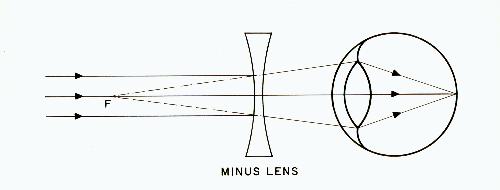
Fig. 4
These glasses cause the parallel rays to diverge just enough so that the eye can focus them on the retina. They make the eye feel (with regard to focusing effort, at least) that the viewed object is actually closer than it is. In fact, if you follow the dotted lines, you will see that point F is where the viewed object appears to be. In this example, F is also the focal point of the lens. Minus lenses thus move the world closer to the eyes. Note that with these lenses, there is no longer any way that the eye can receive parallel rays. All light rays are diverging to a greater or lesser extent. Since the cause of myopia is too much close work, it is obvious that such glasses, by moving everything closer, will aggravate the condition.
Most of the damage occurs when such glasses are used for reading. Many people use their distance glasses for reading even though they could read without them, merely because the eye specialist has never advised against it. There are also many people who must use their glasses for reading because their myopia has progressed to the point that if they take their glasses they will find that even the book is blurred. Their far point or limit of clear vision is not far enough to reach the book.
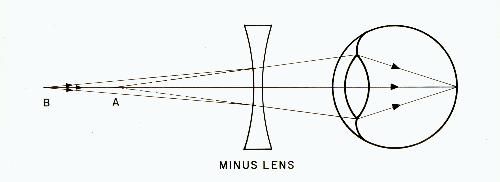
Fig. 5
Figure 5 shows what happens when these minus lenses are used for reading. The book, actually located at B, now appears to be at A. Now the eye, instead of focusing on the book at B, must accommodate more and focus at A. This simple fact explains why such glasses are so harmful.
A vicious cycle now develops. The minus glasses bring everything closer, making increased accommodation necessary. The increased accommodation causes further lengthening of the eye with the resulting need for even stronger glasses. Many children find they need stronger glasses as often as once a year.
If minus lenses were never prescribed, the myopia would only increase to the point where the usual close work could be done without the need for accommodation. There it would cease at a moderate amount, perhaps 3 diopters.
The present, almost universal, practice of allowing a child to read with concave "distance" glasses is ruining the vision of millions of children. Imagine going to a dentist with a toothache and being given medication to remove the symptom (pain) so that you again felt fine. Imagine also that the medication not only failed to stop the decay but even made the decay get worse faster. Each time the pain would begin again, you would return to the dentist for more of the same kind of treatment until finally the tooth became permanently damaged and perhaps useless. This is similar to what we are doing on a regular basis to our children's vision, merely because the errors of the past are being handed down from generation to generation.
It is the old story of treating symptoms and ignoring causes, a situation that has always prevailed in the "healing professions." Prevention is the highest form of health care. The second highest form is treatment of existing problems by removing the cause. A poor third is the treatment or removal of symptoms but ignoring the cause. The fourth, and by far the worst form, is ignoring causes and treating symptoms in a manner that causes the basic problem to get worse. It is in this fourth category that we must place the prescription of concave lenses for acquired myopia.
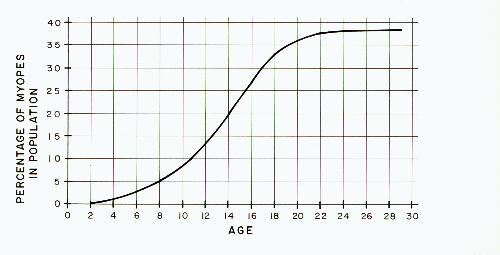
Fig. 6
Figure 6 shows very approximately the percentage of myopic persons at various ages in the United States.1 It is easy to see that the great increase in myopia begins during the early school years. When the school years are completed, the increase levels off. The reason is that if a person is going to develop myopia, it will usually have developed by the time adulthood is reached. Also, it is during the juvenile years, when the eyes are most flexible, that prolonged close work has the most damaging effect on the lengthening of the eyes. In adulthood, the coats of the eyes seem to lose much of their flexibility and do not stretch as readily in most people. It should be remembered, though, that a small number of people do find their myopia increasing through adulthood. These are usually people who have become myopic at an early age and found their myopia rapidly increasing over the years. It may be that the coats of their eyes have become so stretched and so thinned an early age that they do not attain the strength of the normal adult eye. It would thus be easier for these eyes to continue stretching from the stress of continued close work. Or, there may be other reasons, as yet unknown, why their eyes are unable to withstand the stress of close work as well as most adult eyes. Some doctors choose to call this "pathological myopia", meaning that it is somehow different from simple myopia. There is, however, no basic difference. Both are simply "acquired myopia."
If we were to draw a graph showing the rate at which a typical person becomes myopic, it would look quite similar to the one shown in figure 6. It would only be necessary to change the vertical column, as in figure 7, to read "amount of myopia" instead of "percent of the population."
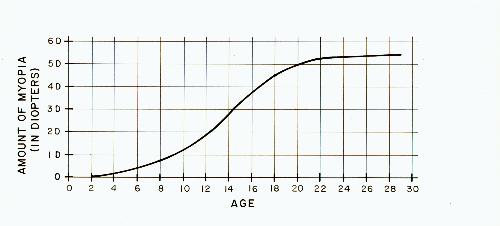
Fig. 7
The harmful effect of minus lenses is often easy to demonstrate. If a myopic child is given minus lenses to read with for, say, one-half hour, the distance vision after removing the glasses is often found to be appreciably worse than before. The vision can be tested before and after the experiment by using an ordinary wall chart. In other words, the eyes have adapted to the minus lenses by temporarily becoming more myopic. If this type of eye abuse is continued long enough, the distance vision will be permanently damaged.
Concave lenses have been called a poison. They are worse than that. They are more like an addictive drug. With a little imagination, it is possible to see some similarity between putting concave lenses on a beginning myope and giving such a drug to the child. Both the lenses and the drug can be considered addictive insofar as their use results in an ever-increasing dependency and a need for stronger and stronger doses to get the same effect. Both can cause permanent damage to the body if their use is continued for too long. However, it is possible to overcome a dependency on drugs. By going through a withdrawal period, the drug addict can overcome the addiction and begin a new life free from symptoms. The concave lens addict is not so fortunate. The abnormal lengthening of the eye that these lenses cause is permanent. Trying to withdraw from this addiction is futile since the eye will not return to its original shape. The drug pusher is none other than your eye doctor.
Lighting. Reading with distance lenses obviously tends to make the vision get worse, particularly in children. If the reading is done under conditions of poor lighting, the vision will generally deteriorate faster than if good lighting is used. The following diagrams will make clear why this is so.
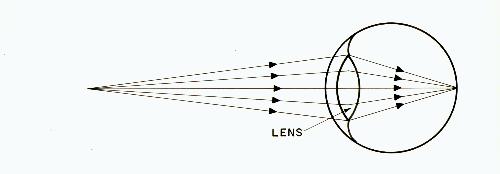
Fig. 8
Figure 8 represents an eye where the pupil is very large (as it would automatically become under poor lighting), and the entire lens is being used to receive light rays. It is apparent that those rays farthest from the center of the lens must be bent more than those close to the center. In fact, the ray of light passing through the center of the lens does not have to be bent at all.
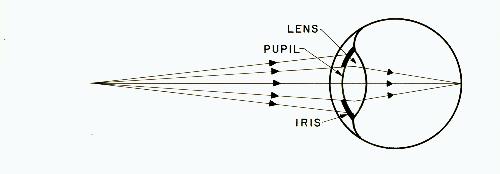
Fig. 9
Now look at figure 9, which represents an eye that is being used under a high amount of illumination. The iris has contracted, making the pupil quite small. The periphery, or outer portion of the lens, is not being used. The only light rays passing through the lens are those near the center, which require little bending, while the most divergent rays do not reach the lens at all.
What this means is that the eye does not need to accommodate nearly as much when viewing an object in bright light as it does in poor light. It has long been recognized that the brighter the illumination, the less the accommodation. This is extremely important to the myope, since excessive accommodation is at the heart of the myopia problem.
It is common for parents to tell their children not to read in poor light, but there are very few people who have any idea about exactly how the eyes might be harmed by poor light. They really can't be expected to know since most eye doctors don't recognize the real reason; or if they do know, they do not tell their customers. There is an easy way to demonstrate for yourself how vision can be improved just by cutting off the rays of light that pass through the periphery of the lens. Take a thin piece of cardboard and cut it to be about the size of an eyeglass lens. Punch several holes through it as shown in figure 10.
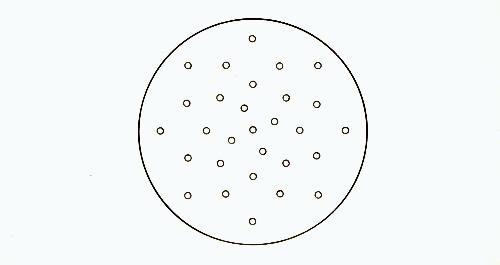
Fig.10
If you wear glasses, take them off, close one eye, and look through the disc. You will probably notice that your vision is clearer when looking through the disc than when using the unaided eye. Whichever hole the eye happens to look through will restrict the rays to the center of the pupil. Since these rays don't need to be bent very much, any refractive errors in the eye (such as myopia or astigmatism) do not affect the vision as much. Whether you make the pupil smaller through increased lighting or create an artificially small pupil by looking through a pinhole, the effect is the same. Accommodation diminishes.
From the viewpoint of myopia progression, it would be much better for a beginning myope to wear pinhole glasses than minus lenses. It should be readily seen that while both devices will clear up the distance vision, the pinhole glasses can do so without bringing accommodation into play. One drawback of these glasses is that they reduce the amount of light entering the eye, and thus make things look darker. They also restrict the field of view. However, they should be more widely used than they are at present. They are described in more detail in the chapter on pinhole glasses.
We might note, while we are on the subject of minus lenses, that there is a simple way to determine whether or not a person is nearsighted, just by looking at the type of glasses that are being worn. If you look at a person's face through the edge of the glasses, you will notice that the side of the face appears to be shifted toward the nose as in figure 11. In other words, the eyes and face appear smaller. This also works in the opposite direction. There is a 2% minification for every diopter of lens power. A person who wears -5 eyeglasses will see the world at only 90% of its actual size.
Plus lenses for farsighted people, on the other hand, shift the face outward rather than inward. Plus or convex lenses, whose workings will be explained in more detail in a later chapter, are thicker at the center than at the outside.
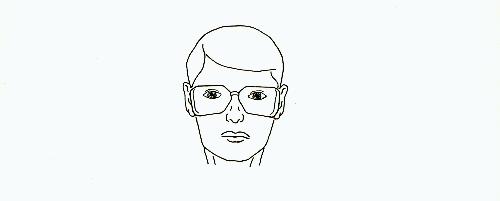
Fig.11
The wrong treatment. As things now stand, nearsighted children are given minus lenses and farsighted children are given plus lenses. Both are wrong and are worse than giving no lenses at all. Minus lenses accelerate the harmful elongation of the nearsighted eye, and plus lenses hinder the proper elongation of the farsighted eye. Minus lenses are stimulants to eyes that are in need of accommodative relaxation. Plus lenses are relaxants to eyes that are in need of accommodative stimulation.
There are those who say, "How will the myopic child see if we don't prescribe glasses?" This shows a lack of imagination. Children do not need clear distance vision for outside activities or around the house. About the only place where there is a problem is in school. If blind students can earn college degrees, surely we can make arrangements so that myopic children can see the blackboard without resorting to glasses. They can be allowed to sit in the front rows, the teacher can write larger, the blackboard can be better lighted, they can use pinhole glasses, etc.
There is no harm or discomfort to a child if the blurred distance vision is uncorrected. It can only be beneficial. There are, in fact, many myopes who aren't even aware of their problem. They think it is normal for distant objects to be a little blurred.
It is also a fact that many doctors "overcorrect" for myopia. Instead of prescribing lenses that give 20/20 vision, they prescribe lenses that are even stronger and give 20/15 vision. This can only make the myopia get worse faster. Actually, even a person with normal vision will seem to see better through a weak minus lens. White seems to appear whiter and black blacker. This certainly does not mean that such a correction is needed or desirable.
Unbelievable as it may seem, many myopic children are told by their doctors that if they wear glasses or contacts all of the time their eyes will get better, or at least not get worse. This is totally false. Because of this type of erroneous advice, people actually believe that glasses "save" eyes. The truth is that minus glasses destroy myopic eyes.
It may surprise you to learn that many eye doctors act according to the philosophy that there is nothing wrong with wearing glasses. They reason that glasses do not cause much inconvenience, that they are so common these days that no one looks strange wearing them, and that so many types and fashions are available that glasses can actually "improve your looks." In addition, one hears the argument that some nearsighted people (if they are lucky enough to develop just the right amount of nearsightedness) merely need to remove their glasses to read after they reach the age when non-nearsighted people must put on reading glasses to read (a condition called presbyopia). By reasoning or rationalizing in this manner, they can go about their business of prescribing glasses for young and old with no disturbance to their conscience and without concerning themselves about anyone's vision getting worse because of the eye doctor's actions.
To try to play down all the obvious disadvantages of eyeglasses, the advocates of "glasses for everyone" have even gone so far as to get well-known athletes to tell the public that it is possible to be successful in the sports world in spite of wearing glasses. They even give awards to such athletes as part of the propaganda. Glasses are extensively promoted as "fashion accessories." Apparently, these people will not be satisfied until they have put eyeglasses on everyone, and the sight of "naked eyes" is an oddity.
The dangers. Most people are already aware of the most obvious drawbacks of having to wear glasses, such as distortion, reduced field of view, expense, poor appearance, inconvenience, reduced vision because of dirt or rain on the glasses, etc. However, they are not aware of the more serious results of increasing myopia. Let us look at some of these more serious problems.
As myopia develops and the eye becomes longer than normal, the volume of the vitreous chamber becomes greater. Since the vitreous body is more firmly attached to the lens than to the retina, the support it provides for the retina becomes diminished. The vitreous becomes more watery, further decreasing retinal support. These changes, coupled with the stretching of the retina, make retinal detachment more likely in the myope than the nonmyope.
Because of this watery substance in the vitreous chamber, myopes are more likely than nonmyopes to be disturbed by floaters. These are odd-shaped spots that appear to float and jump around in the field of vision, particularly when looking at a white surface and making sudden eye movements. These particles are located in the vitreous chamber. They may have been present from birth and can occur in both myopic and nonmyopic eyes. Others may develop during the myopic elongation of the eye. Usually, the floaters are not a cause for concern and they may not even be noticed most of the time. However, the watery vitreous of myopic eyes enables the particles to move around more easily, and they are thus more noticeable and disturbing than in nonmyopic eyes.
People who ask their doctors about the "spots" they sometimes see are usually not told that the problem frequently arises only because myopia has been allowed to develop. Furthermore, if the floaters are increasing in number, this could be a sign that the myopia has progressed to the point where degenerative processes are taking place at the surface of the retina, and the particles of material resulting from this degeneration are leaving the retina and passing into the watery vitreous. A large number of floaters can thus be a sign that a retinal detachment is about to occur.
Even if retinal detachment does not occur, high myopes are prone to various forms of deterioration at the rear of the eye (that is, to various forms of macular degeneration) resulting from the abnormal stresses caused by the elongation.
In Chapter 2, figure 1 shows how the eye can get larger in advanced myopia. Note that it is only the vitreous chamber that enlarges. The front of the eye remains unchanged. Because of this stretching, the sclera can, in extreme cases, be reduced to one-quarter or less of its original thickness. At some point during the enlargement of the eye, a pathological state begins to develop. That is, we are no longer dealing with a case of simple myopia, but with a diseased eye. Among the main changes are generalized atrophy of the retina and choroid, and degeneration at the point where the optic nerve leaves the eye and in the macular area (where the fovea is located). Hemorrhages can occur at various places. Because of the atrophy at the fovea, central vision begins to be lost. Macular degeneration can also be caused by clogged arteries to the eye, resulting from atherosclerosis which is due to too much fat in the diet.
Similar mechanical and degenerative changes occur in the vitreous. Since the vitreous has become quite watery, large floating spots of degenerative material can be easily seen. The tearing and hemorrhaging of the retina lead to retinal detachment, allowing the watery vitreous to flow between the retina and choroid. The watery condition of the vitreous thus aggravates the tendency toward detached retina. If actual detachment does not occur, the degenerative changes can progress slowly until no useful vision remains. In either case, blindness often results.
Large numbers of people lose their sight each year due to these complications of high myopia. The British Government lists myopia as the third most frequent cause of blindness, after diabetes and congenital defects.2
Retinal detachment is not to be confused with vitreous detachment, a condition where the vitreous body pulls loose from its attachment to the retina at the back of the eye. This happens to many people as they age and is generally not cause for concern. Momentary flashes of light are frequently seen off to the side when the eyes are moved, particularly at night, as this takes place. These flashes are thought to be due to the vitreous body putting momentary tension on the retina. They diminish in time.
When the metabolism of the lens becomes faulty, the lens fibers can become swollen or distorted, and gaps filed with fluid and debris form among them. When these degenerative changes begin to cause the incoming light to scatter rather than be transmitted, the person is said to have a cataract. The only solution at present is the surgical removal of the lens and the use of strong glasses, contact lenses or lens implants to compensate for the loss of the lens. Replacing the lens of the eye with an artificial lens risks infection or other complications, resulting in blindness. Throughout the world, the total number of people each year who find their vision impaired by cataracts probably runs into the millions. Both time and patience are required after surgery in order to adapt to the restored vision. If an artificial lens is not implanted, thick, heavy glasses must be worn to compensate for the lens that has been removed. Such glasses cause considerable distortion of the surrounding world, increased magnification of the image on the retina, decreased depth perception, and disturbances of the field of vision. Some people require many months to adapt to these effects and a few people never learn to tolerate them.
As aggravating as these problems are, they are almost insignificant when compared with the more serious problem that awaits many of these people. It is not widely known among the public that cataract surgery, by its drastic alteration of the tissues and of the hydraulic forces inside the eye, predisposes that eye to tearing or detachment of the retina. The typical person who suffers through two cataract operations, believing that they will result in clear vision from then on, is totally ignorant of the fact that the operations can set up conditions that frequently result in serious retinal problems a few years later.
While this situation is bad enough for the nonmyopic patient, a considerably worse situation exists for the moderate or high myope. The eye that has become overelongated and myopic from years of using concave lenses is predisposed to retinal deterioration even before cataract surgery. If the lens of such an eye is removed, this tendency is increased even further. A high myope facing cataract surgery has little to be optimistic about.
The fact that so many people develop cataracts is yet another reason why myopia must be prevented in our children. They will then have a better chance of avoiding blindness if a cataract operation should ever be required. Even a small amount of myopia, if allowed to develop, unnecessarily increases the already present danger of retinal problems in those who undergo cataract surgery.
Few of these people, faced with the prospect of blindness in old age, realize that their problems actually began in childhood when they were fitted with that first pair of concave lenses by someone who was unconcerned about the tragic, long-range results of that action. Few of these people realize how their situation became more precarious each time their glasses were strengthened and nothing was said about prevention. Then, when it is too late for prevention, they find themselves in the hands of surgeons, who are making their living from someone else's mistakes by trying to patch up steadily deteriorating retinas. These people have been lifelong victims of ignorance and exploitation.
The day may come when proper living habits are universal and the degenerative metabolic processes that result in cataracts will not take place. Until that day, we have yet another compelling reason to prevent myopia so that the cataract patient has a better chance of retaining what vision is left after surgery.
High myopia can be a tragic affair, and the earlier that concave glasses are put on a child the more years there will be ahead for the myopia to develop serious complications. There is obviously a great deal wrong with being nearsighted, and those who claim otherwise are doing the public a disservice.
Bringing these disquieting facts into the open is not a pleasant task. Many people don't want to hear about such things. Nevertheless, you cannot protect yourself from harm without being made aware of the danger.